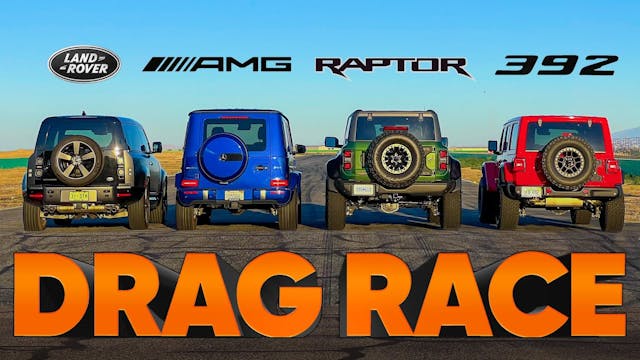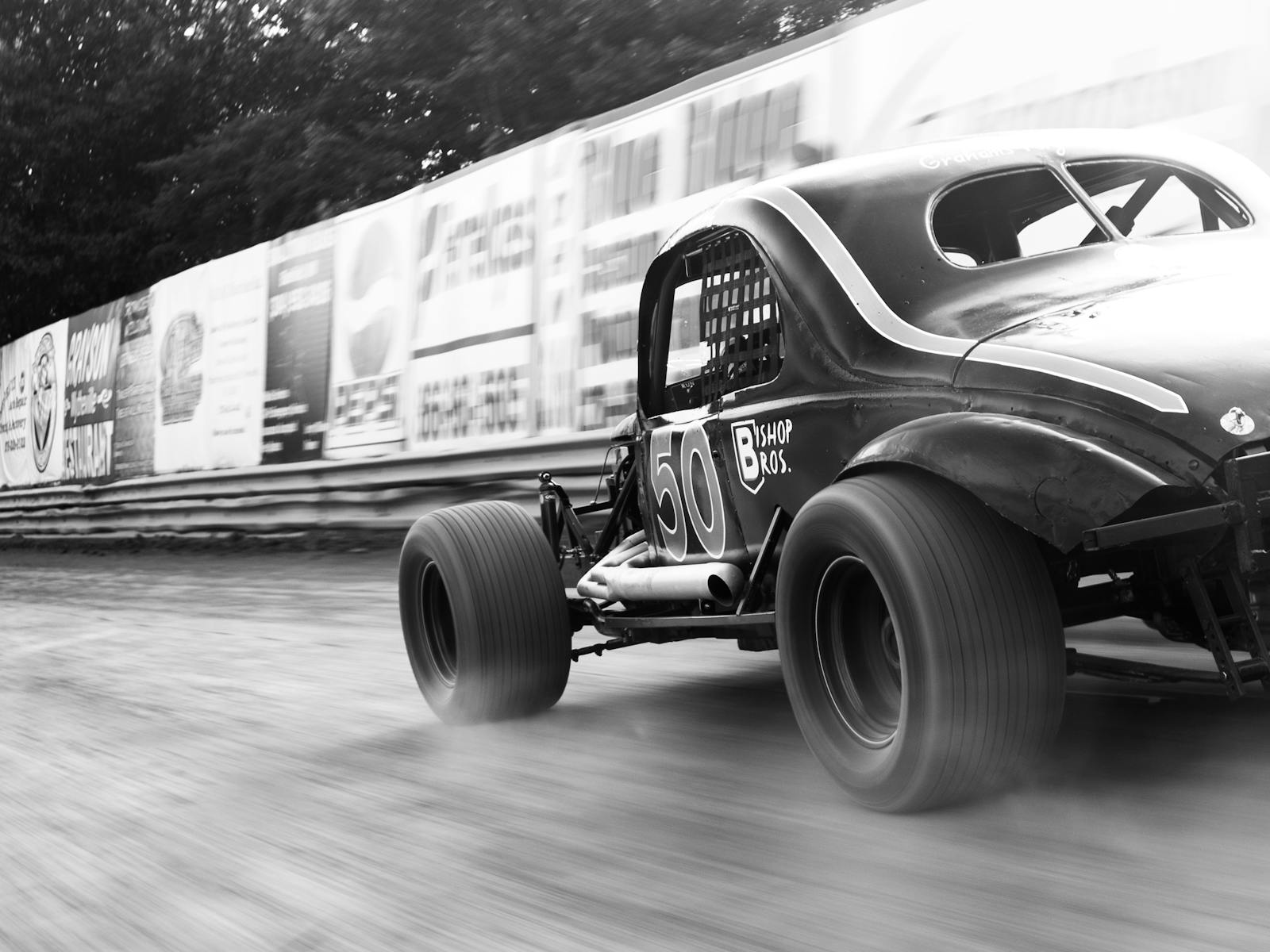1320 feet, 1983 hp: Bronco Raptor vs. Rubicon 392 vs. Defender V8 vs. G-Wagen
There is nothing quite as American as taking an off-road-oriented SUV and stuffing enough motor up its snout to turn quarter-mile times that would shame yesterday’s pony cars. In the latest episode of Ultimate Drag Race Replay, host Jason Cammisa pits two of America’s rowdiest SUVs against worldwide offerings with similar muck-turned-muscle pedigrees. Let’s meet the contenders.
The newest super-ute hails from Dearborn by way of the Cretaceous Period: Ford’s Bronco Raptor. With a twin-turbocharged, 3.0-liter EcoBoost V-6 sending 418 hp and 440 lb-ft to all four wheels through a 10-speed automatic, this sandy Scud missile is ready to devour anything—rocks, dirt, pavement, poodles, etc.—in its path.
The only thing stateside that might prove too big for the Braptor to chew, however, is Jeep’s Wrangler Rubicon 392. You know it well: 6.4 liters of Hemi V-8 fury, 470 hp, 470 lb-ft, eight forward gears, and a penchant for waking the neighbors.
To decide the king of the star-spangled hill, Cammisa lines up the Braptor and the Wrangler. 3… 2… We’ll spoil the result here: the Rubicon wins—but you’ll need to watch the video to see the margin of victory. (It’s considerable.) Dead dinosaur in rearview, the Wrangler steps up to the world stage, where it meets two formidable contenders from Germany and England.
First, Mercedes-AMG’s G 63, the inimitable Geländewagen in peak road-going form. Its twin-turbo, 4.0-liter V-8 churns out a whopping 577 hp and 627 lb-ft of torque, meted to all four wheels through a nine-speed automatic transmission.
Though down on power relative to the G, Land Rover’s Defender 90 V-8 still packs a punch: 518 hp and 461 lb-ft of torque from a 5.0-liter supercharged V-8, delivered to all four wheels through an eight-speed automatic.
There’s no replacement for watching the three brutes in a dead sprint, but the G takes the bacon … handily. More interesting, perhaps, is how well-matched the Wrangler and the Defender are. As Cammisa explains, the Wrangler’s short gearing is a boon off the line, but once the Defender’s running through the longer gears, the gap opened by the Jeep closes at an alarming rate. Had this makeshift drag strip been two feet longer, the Defender would have clipped the Hemi-huffin’ Rubicon.
Because this is his show and he makes the rules (and that document only has like, four lines in it), Cammisa also pits the Über-G against a different foe: a 2004 Lamborghini Gallardo. Despite a yowling, 493-horse V-10, an aerodynamic shape, and a curb weight that’s nearly one whole Miata lighter than the G, the race is much closer than you’d expect.
“Who wins the race” is an easy question to answer; the why is a bit more complicated. For instance, how does a SUV like the Defender V-8, which has 48 extra ponies and just 75 pounds of surplus heft, get dropped off the line by the Jeep? In short, gear ratios—specifically the final drive ratios of the Rover and Jeep’s rear axles (3.6 vs. 4.56, respectively). The latter helps the Jeep catapult to 60 mph nearly a half-second quicker. The Jeep’s off-the-line advantage comes despite its chunky, 35-inch tires; the Defender has an easier time, clad in 32-inch rubber.
Tire type also plays a factor here. Both the Jeep and the Braptor wear portly BF Goodrich KO2 rubber clearly meant to lay waste to dirt and rocks, not to slay stoplights. Meanwhile, the Rover and the G 63 get serious street-spec rubber from Continental and Pirelli, respectively. Aside from providing better off-the-line grip, the latter tires’ lower rolling resistances enables the two overseas competitors to reach top speeds of 150 mph, while the Jeep and Bronco fall well short.
(But what happens if you try drag racing on the dirt? Don’t worry—that one’s coming.)
0-to-60 times below six seconds used to be reserved for exotic sports cars and glorious American muscle. As of 2022, off-roaders are now crashing the party. Heck, the quickest of these SUV can toe the line against a Lamborghini that’s barely old enough to buy a pack of Marlboros. If that’s not an indication of how far internal-combustion performance has come in the last decade or two, nothing is.


